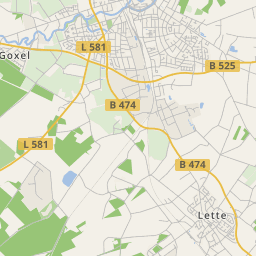












The town is situated in the western Münsterland, around 40 kilometres southwest of Münster at the edge of the nature reserve Hohe Mark. While the river Stever flows directly past the town, the Neue Fahrt of the Dortmund-Ems-Canal runs around two kilometres more easterly and the river Lippe around 5 kilometres south.

The river Lippe form between Eversum and Ahsen (part of the town Datteln) also the town and district border between the district Coesfeld and the district Recklinghausen. The border to the district Unna runs southeasterly along the Lippe and east behind the Dortmund-Ems-Canal.

Wolfhelm, bishop of Münster, to whom the Oberhof Ulfloa belonged and who gifted all of his Olfener possessions to monastery Werden in 889, gave the small town its name. After the settlement of tradespeople and craftsmen, Olfen flourished with the expansion of the long-distance trade first along the Rheinischen Straße (B 235) and developed into th a town of lower rights, which had a population of circa 500 around 1500. In the following centuries, Olfen's population had to fight with the consequences of the historical events. Against the background of the Spanish-Dutch war, which affected the Münsterland, a trench-rampart facility was built around 1600. Olfen's citizens constructed the facility unauthorised and illegal to protect themselves from robbery and looting.

Plagues and failed harvests, tax burdens and passing troops paralysed further advancement of the town. Only in the 19th-century, Olfen got new chances through profound social and economic changes and the industrial revolution. The catastrophic fire on the 31st of August 1857, where one person died and 142 houses were destroyed, went down in Olfen's history as the 'The great fire of Olfen'. In 1975, in the course of the territorial reform in North-Rhine Westphalia, the parish Olfen was integrated into the town.